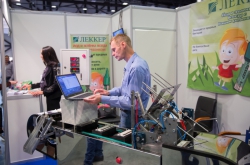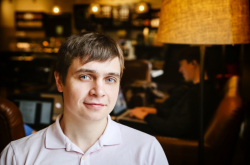How was E-Contenta born?
The idea first came to us in 2014. Our founders were still working in other companies, but they were already thinking about making something on their own that would combine marketing and Big Data analysis. The concept was very vague back then, and we kept going back to the drawing board. From time to time we’d meet in a café and try to figure out what we wanted to accomplish. It all came together in 2015 and we started applying to various foundations. We acquired support from Untitled Venture Fund, who invested in our company. This allowed us to open shop in early 2016.
We provided personal recommendations and focused mostly on working with media and content companies: various online cinemas, e-book companies, music services, e-education, the like – anyone who generates a lot of content.
What is your service’s basic premise?
The premise of E-Contenta is to establish interaction with clients at all stages of their lifecycle: attracting, gaining loyalty and ensuring the return of the userbase. Our technology analyses people’s behavior online and tries to predict what they would like to listen to, watch, read and, of course, buy. For instance, when a user visits a book or music service, they receive recommendations for books or songs they might like. To compile them, the service collects information from social networks, data collection companies, etc. Personal recommendations can be shown on banners, on a webpage, on a mobile or Smart-TV application and used to attract clients to the online-service, to gain their loyalty or to ensure their return.
You started out in Russia. When did you realize that you needed to start expanding abroad?
We were planning a global company from the get-go and tried to make a product that could work on any market. That’s why we soon began to consider how we could enter the American market. This was done while we were working in Russia, where we were able to test various hypotheses and try to transform them into business relationships with clients.
It would be an insane expense to just, say, grab everything and move to the US, open an office there and hire some people – which is why we employed a different strategy by working with business accelerators. We applied for a large number of accelerator programs. There’s a very helpful website I used that shows a great number of options all over the world.
We chose the programs that focused on Big Data – what we ourselves were working with. Last September we received invitations to three different accelerators: Next Media Accelerator in Hamburg, Starta Accelerator in New York and TURN8 in Dubai. We went with New York, as it was most in line with our future development plans. The program started in late September of last year and ended in late December.

Participants of TURN8 Accelerator's DemoDay
What was it like working at Starta Accelerator and which results did you achieve there?
The main task at Starta Accelerator is to bring a start-up onto a new market. I could liken it to learning to swim: no matter how much you’re told how to do it, you can only really learn it when you’re in the water. Starta Accelerator’s method is kind of the same: they take a company that plans to expand onto the American market and “submerge” it into a new business environment. It’s very productive. Starta was the kick in the bottom we needed to move to the USA and start working.
I can underline the three biggest achievements from our work there. First off, we have completely redesigned our product: we turned away from what we first made for the Russian market and focused on a different market with a similar technology. Secondly, we got acquainted with the IBM program and received a grant for 130 thousand dollars from them. And, last but not the least, after taking part in Starta Accelerator we won the favor of another program – the New York Fashion Tech Lab. We’ve been working with them since March of this year.
How do you see the company’s further development? What are your plans for the near future?
Before we took part in the program, our perfect client would have been Bookmate, a book subscription service, the Viasat online cinema or Beeline TV. And they still are – on the Russian market. But it doesn’t quite work like that for the American market. Here, the brand market holds the most potential and interest for us. What do I mean? Well, name any brand.

Let’s say… H&M.
Okay, let’s take a look at their website; there’s a great deal of content here – “How to camp out in California”, “3 old-school skincare techniques”, etc. Each of those articles also has a list of related products you can buy at H&M stores. And, I note, this is not a magazine, this is a clothing chain. But look just how much content they’ve got.
That’s why I said that our approach for the Russian market doesn’t work for the American market? Because content marketing is only taking hold in Russia and the brands there don’t employ it as actively as American ones do. Here’s a number – 30% of all marketing budget in US is spent on content marketing. But when you’ve got content in abundance, the problem is delivering it to the customer – whatever was written by the brand needs to show a specific story. But what will get the customer’s attention, gain his brand loyalty? If there are 10-20 thousand articles on your website, how do you choose what to show to a certain user? This is the area we’re going to be working on and our content recommendation service is going to target primarily brands. This is our chief strategy that we think offers a lot of opportunities for the start-up.
Yet you won’t discontinue your work in Russia.
We really can’t do otherwise. First of all, we have big clients and great projects here – with “Beeline”, for instance, or “Megafon” (Net-by-Net). Secondly, even with the emergence of a great number of American clients, it’s still going to be very advantageous to develop our service here, in Russia. There are great programmers and mathematicians here.

Zoya Andreeva. Credit: medium.com
You often give talks at conferences. What do you think is the most important thing when working on a presentation, especially if you intend to expand your work abroad in the future?
We’re currently looking for investors, so I’m more than familiar with talking to American and Russian investors. Structurally, pitches are the same everywhere. They all want to feel that they can give you ten dollars today and gain a thousand dollars in three years. In that regard Russian, American and any other kind of investors are the same – although there are some cultural differences that need to be kept in mind.
The first thing you need to start doing in the USA is smile. If you’re just bumbling gloomily, you won’t get far. While Russians try to unearth everything from you, ask you questions, Americans usually just move on to somebody else. No one will want to figure out what your start-up is all about.





